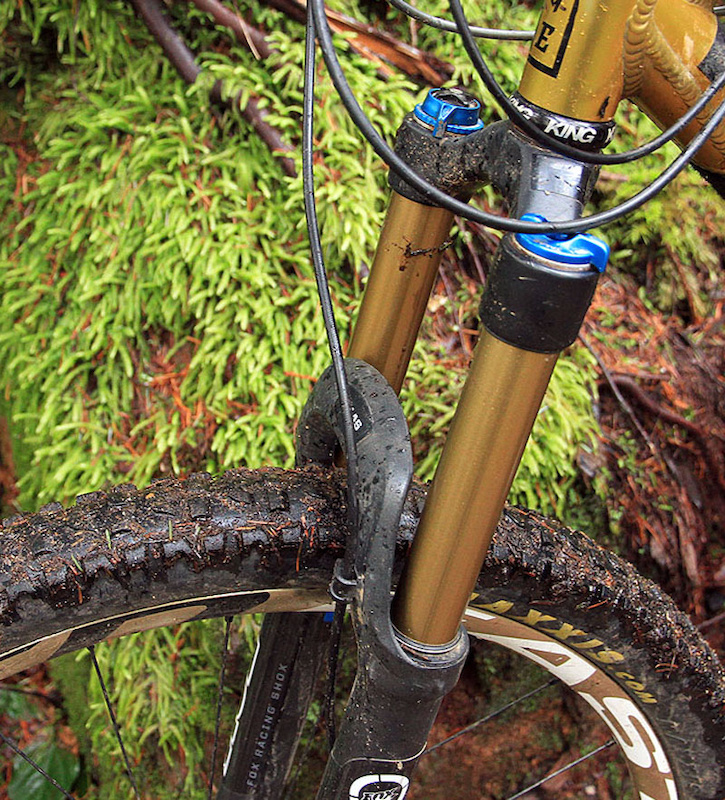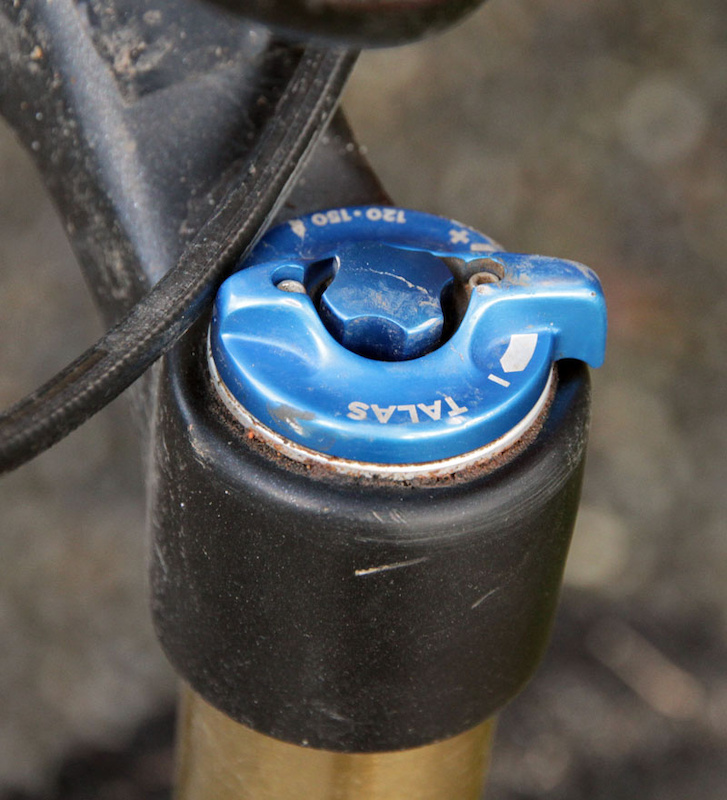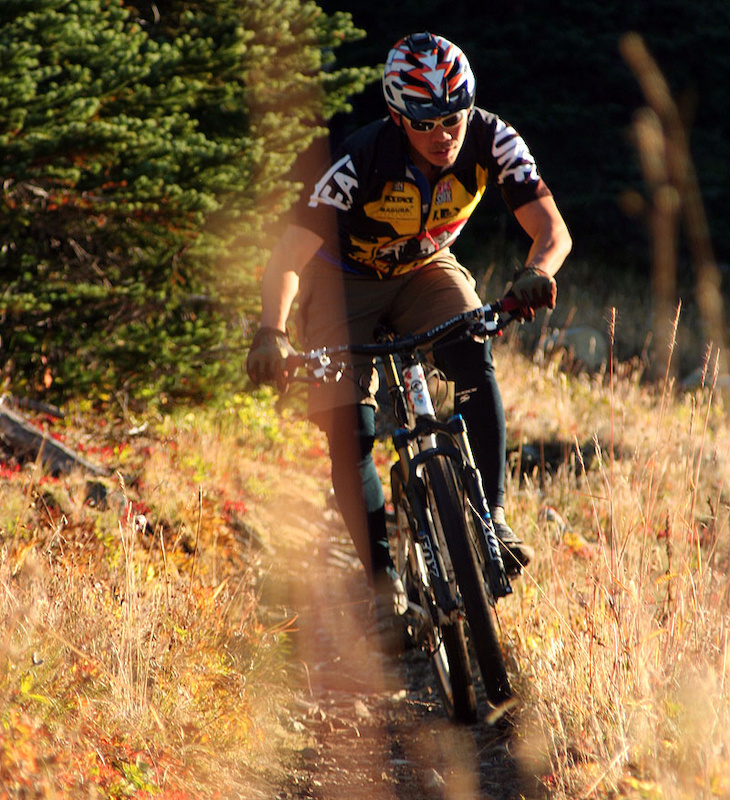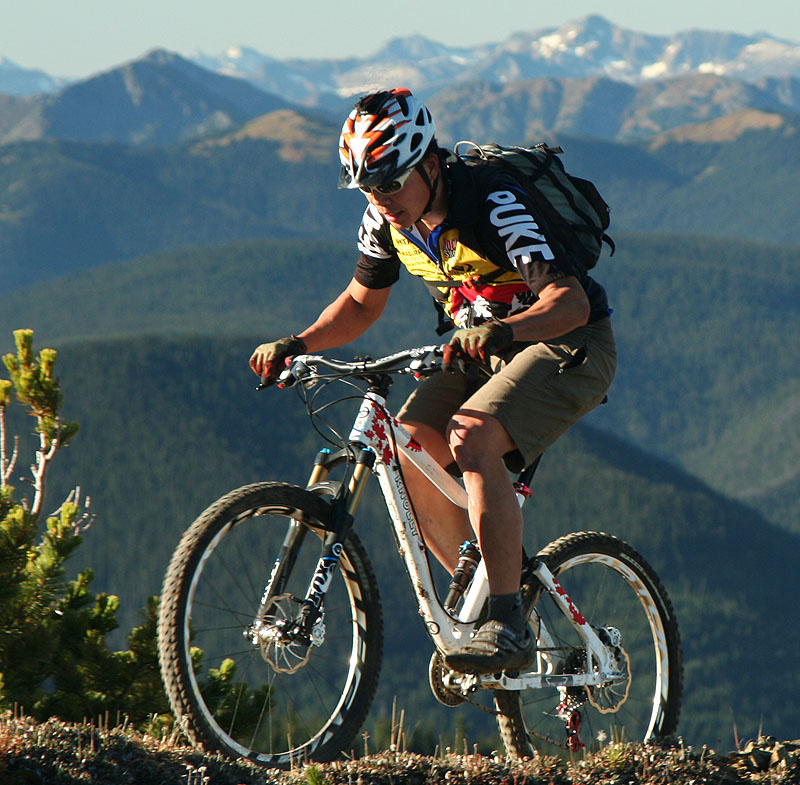Stories posted under Pinkbike Community blogs are not edited, vetted, or approved by the Pinkbike editorial team. These are stories from Pinkbike users.
If a blog post is offensive or violates the Terms of Services, please report the blog to Community moderators.
Fox TALAS 150
New in 2011, the Fox Talas 150 now comes with Kashima coating and has created much anticipation promising to offer long-travel yet light weight.
Introduction
The new Kashima coated forks have created much anticipation. The Fox 32 RLC has changed in 2011 by having more "usable travel with lower compression ratios for better performance and durability, with improved air spring curves, and ultra low-friction Kashima Coat stanchions provide lightning-fast suspension response" . For 2011 the 150 TALAS comes with the FIT HSC Cartridge (first used on this fork in 2010) lockout and Low Speed Compression Settings.
Available in both tapered and 1-18/th steerer the latter weighs in at 3.88 lb / 1.76 kg. The two-step 120-150mm TALAS ihttp://www.foxracingshox.com/bike/10/forks/32_TALASs not much heavier then the 150mm Float (3.75 lb / 1.70 kg, 1 1/8" steerer with 15mm QR). Interestingly the Vanilla is not offered in the 32 lineup for 2011. The 2011 32 TALAS 150 is also 40g lighter than last year. Apparently this is a fork for someone who wants the travel, but not the weight of the 36.
The 15mm through axle quick-release system makes taking the wheel off a snap and is 15g lighter then the 2010 model; adding to the weight savings. The low-speed compression (LSC) and lockout dials are easily accessed at the top right leg, the air spring and travel adjust on the left. Rebound has moved to the lower right leg.
Design and Construction:
- 150 3.88 lb / 1.76 kg
- 5.9 inches / 150 mm (2011 TALAS [2-position] 150-120)
- Axle to Crown 520.9mm
- Max Tire size - 26 X2.4
- External Adjustments: (i) Low-speed compression; (ii) Lever actuated lockout; (iii) Lockout force adjust; (iv) Travel - TALAS [2-position]
More design and construction details
- Air spring pressure (max 150psi)
- Rebound
- FIT Damper
- Kashima Coating on 32mm Stanchions
- 15QR thru axle system,
- Post style disc brake mounting
- 9mm open drop-out,
- Post style disc brake mounting
- Straight 1 1/8" or tapered steerer
- Air Sprung
- Designed for All Mountain and Freeride applications
Design Features:
New for the 2011 fork is the two step TALAS (the older versions are three step) and Kashima coating. The Talas 150 has the 15mm QR; lots has been written about this standard that does not warrant rehashing.
Kashima
Developed by the Miyake Company of Japan to improve the characteristics of aluminum by making the surface harder, more abrasion resistant and offer less friction then untreated hard anondized aluminum. Proven in the motorcycle industries for many years to offer low-friction and wear resistance properties.
In the Kashima Coating process, lubricating molybdenum disulfide is deposited via electrical induction into the billions of micropores on the surface of hard-anodized aluminum. Since 2009 when it was first introduced into the international mountain bike racing circuit, the distinctive gold colored Kashima coated stanchions have been reported to offer better lubrication characteristics, attain a level of hardness and abrasion resistance four times tougher than standard hard-anodized aluminum in lighter weight package.
Previous All Mountain Forks used :
I have had extensive experience with Fox Talas 36 forks (160mm) and RockShox Lyrik variations (also 160mm). I had also ridden the 2009 iteration of this fork on a Scott Genius. On the shorter travel end of all-mountain I've also had experience on the Magura Thor as well as with the RockShox Revelation, both of which were 140mm travel forks.
Testing Environment and Setup:
The Talas was used on two bikes and ridden on a variety of trails in North Vancouver and then in Utah (namely the St George area in South West Utah as recounted here. To summarize, the fork was mainly ridden on technical trails.
The Talas 150 was first put on a Knolly Endorphin (140mm travel AM bike - definitely biased to the heavier side of AM) . It then went on a Edge Cycles Icarus; basically a long - travel version of the Titus Racer-X but with a light all-mountain build. An Easton Havoc AM wheelset was used on both bikes primarily to take wheelset stiffness out of the comparison equation and secondarily because they are just so darn bling!
Suspensionwerx of North Vancouver helped me set up the fork. Initial settings for appropriate sag were 90 PSI, LSC 4 clicks in. I weigh 160lbs and found that I had to fine-tune the air pressure to get all the travel. Eventually I ended up setting the fork at 80PSI.
Performance:
1. Tuneability
Prevailing wisdom is that air springs are easily tuneable but sometimes can give up small bump sensitivity. I was pleased to find that the Talas 150 was indeed very tuneable, behaving very differently when you changed air pressure. Yet, such is the magic feel of Fox forks, the Talas 150 was still quite small-bump compliant. I won't insult the reader by comparing it favorably to a brake-bump eating coil downhill fork but compared to other forks in its class, the Talas 150 was exceedingly tuneable. Pump the pressure up 10 psi and it felt like a xc fork. Drop it 10 psi and it ate up rough terrain.
![photo]()
2. Downhill
This segues nicely to the next section. I was underwhelmed by the Talas 150 when it was used on the Knolly Endorphin finding it to be flexy and overwhelmed by bigger hits. The Endorphin is ridden very aggressively; I frequently stuff the front - end into steep technical sections at speed. In those situations the fork was non confidence-inspiring; the Talas 150 would deflect and occasionally bottom-out despite fine-tuning compression and other suspension settings. Bear in mind that although the Knolly Endorphin is "only" 140mm of rear travel it has a reputation of being among the stiffest of bikes in its class and I ride it accordingly. This may explain my largely unfavourable reaction to the 2010 Talas 150 as I had positive impressions of the 2009 Talas 150 when it was paired with a bike that was considerably less burly/stiff (the aforementioned Scott).
My suspicion that the Fox Talas 150's downhill performance is best optimized when it is spec'ed on a bike that is not quite so aggressive was confirmed when I tried the fork on the Edge Icarus. I don't ride the Edge as aggressively as I do the Endorphin. The Edge is a capable bike but it is not comparable in downhill performance to the Endorphin being much more climbing-biased. Paired with the Edge, the Talas 150 performed very well. It's worthwhile noting that the Talas 150 has the same characteristics in its lower travel setting as in the higher travel, compression, small and large hit sensitivity remain the same. You won't blow through any detents and are able to ride the fork as aggressively as any other 120mm travel fork when riding in lower travel setting.
I can't pin down a reason that the Fox Talas 150 felt so undergunned especially compared to something like a Fox 36 (which admittedly is heavier). It could be a combination of the 15mm QR, or the 32mm stanchions or the overall effect that weight-shaving has on a long-travel fork. All I can convey are personal impressions.
3. Uphill
At under 4lbs, the Talas 150 is light. Weight weenies will relish the savings and the consequent ability to shave grams while maintaining fairly long - travel. Thus the weight weenie can then build a light bike which theoretically helps the weenie climb better.
In terms of things which actually affect climbing characteristics, I've always liked the Fox travel adjust mechanism setting and the Talas 150 is no exception. One twist of a dial and you change between 120mm to 150mm of travel. I use this feature on longer climbs. For shorter climbs I rely on the excellent platform inherent to Fox forks which allows me to power up without overt amounts of front-end bobbing.
Overall Impression:
To summarize, I found the Talas 150 to be a compromise that missed the mark.
I If I sound lukewarm about the Talas 150 it's because I've come to expect so much out of the Fox family of suspension products. For my type of riding, given the trails I ride, the Talas 150 is not enough fork for the aggressive end of the spectrum, yet overkill for the light use end of the spectrum. In my opinion (emphasis added) used by a rider in somewhat less technical and aggressive terrain, the Talas 150 would fit the bill as a fantastic front - end for an all-mountain/light free-ride bike. But not for me.
I could not tell a difference between the Kashima-coated Talas 150 and my non-Kashima coated 2009 version even in a blind test. I would assume that long-term the Kashima coating will hold up better but having said that, I haven't had issues with the standard Fox anodization.
Just because its mid-winter, Utah scenery is cool and Sharon's on a blinged out gold bike with the Talas 150 here is a video
Introduction
The new Kashima coated forks have created much anticipation. The Fox 32 RLC has changed in 2011 by having more "usable travel with lower compression ratios for better performance and durability, with improved air spring curves, and ultra low-friction Kashima Coat stanchions provide lightning-fast suspension response" . For 2011 the 150 TALAS comes with the FIT HSC Cartridge (first used on this fork in 2010) lockout and Low Speed Compression Settings.
Available in both tapered and 1-18/th steerer the latter weighs in at 3.88 lb / 1.76 kg. The two-step 120-150mm TALAS ihttp://www.foxracingshox.com/bike/10/forks/32_TALASs not much heavier then the 150mm Float (3.75 lb / 1.70 kg, 1 1/8" steerer with 15mm QR). Interestingly the Vanilla is not offered in the 32 lineup for 2011. The 2011 32 TALAS 150 is also 40g lighter than last year. Apparently this is a fork for someone who wants the travel, but not the weight of the 36.
The 15mm through axle quick-release system makes taking the wheel off a snap and is 15g lighter then the 2010 model; adding to the weight savings. The low-speed compression (LSC) and lockout dials are easily accessed at the top right leg, the air spring and travel adjust on the left. Rebound has moved to the lower right leg.
Design and Construction:
- 150 3.88 lb / 1.76 kg
- 5.9 inches / 150 mm (2011 TALAS [2-position] 150-120)
- Axle to Crown 520.9mm
- Max Tire size - 26 X2.4
- External Adjustments: (i) Low-speed compression; (ii) Lever actuated lockout; (iii) Lockout force adjust; (iv) Travel - TALAS [2-position]
More design and construction details
- Air spring pressure (max 150psi)
- Rebound
- FIT Damper
- Kashima Coating on 32mm Stanchions
- 15QR thru axle system,
- Post style disc brake mounting
- 9mm open drop-out,
- Post style disc brake mounting
- Straight 1 1/8" or tapered steerer
- Air Sprung
- Designed for All Mountain and Freeride applications
Design Features:
New for the 2011 fork is the two step TALAS (the older versions are three step) and Kashima coating. The Talas 150 has the 15mm QR; lots has been written about this standard that does not warrant rehashing.
Kashima
Developed by the Miyake Company of Japan to improve the characteristics of aluminum by making the surface harder, more abrasion resistant and offer less friction then untreated hard anondized aluminum. Proven in the motorcycle industries for many years to offer low-friction and wear resistance properties.
In the Kashima Coating process, lubricating molybdenum disulfide is deposited via electrical induction into the billions of micropores on the surface of hard-anodized aluminum. Since 2009 when it was first introduced into the international mountain bike racing circuit, the distinctive gold colored Kashima coated stanchions have been reported to offer better lubrication characteristics, attain a level of hardness and abrasion resistance four times tougher than standard hard-anodized aluminum in lighter weight package.
Previous All Mountain Forks used :
I have had extensive experience with Fox Talas 36 forks (160mm) and RockShox Lyrik variations (also 160mm). I had also ridden the 2009 iteration of this fork on a Scott Genius. On the shorter travel end of all-mountain I've also had experience on the Magura Thor as well as with the RockShox Revelation, both of which were 140mm travel forks.
Testing Environment and Setup:
The Talas was used on two bikes and ridden on a variety of trails in North Vancouver and then in Utah (namely the St George area in South West Utah as recounted here. To summarize, the fork was mainly ridden on technical trails.
The Talas 150 was first put on a Knolly Endorphin (140mm travel AM bike - definitely biased to the heavier side of AM) . It then went on a Edge Cycles Icarus; basically a long - travel version of the Titus Racer-X but with a light all-mountain build. An Easton Havoc AM wheelset was used on both bikes primarily to take wheelset stiffness out of the comparison equation and secondarily because they are just so darn bling!
Suspensionwerx of North Vancouver helped me set up the fork. Initial settings for appropriate sag were 90 PSI, LSC 4 clicks in. I weigh 160lbs and found that I had to fine-tune the air pressure to get all the travel. Eventually I ended up setting the fork at 80PSI.
Performance:
1. Tuneability
Prevailing wisdom is that air springs are easily tuneable but sometimes can give up small bump sensitivity. I was pleased to find that the Talas 150 was indeed very tuneable, behaving very differently when you changed air pressure. Yet, such is the magic feel of Fox forks, the Talas 150 was still quite small-bump compliant. I won't insult the reader by comparing it favorably to a brake-bump eating coil downhill fork but compared to other forks in its class, the Talas 150 was exceedingly tuneable. Pump the pressure up 10 psi and it felt like a xc fork. Drop it 10 psi and it ate up rough terrain.

Based on the (IMO correct) theory that rebound is set and forget, the rebound knob is once again relocated to the common bottom of fork leg position
2. Downhill
This segues nicely to the next section. I was underwhelmed by the Talas 150 when it was used on the Knolly Endorphin finding it to be flexy and overwhelmed by bigger hits. The Endorphin is ridden very aggressively; I frequently stuff the front - end into steep technical sections at speed. In those situations the fork was non confidence-inspiring; the Talas 150 would deflect and occasionally bottom-out despite fine-tuning compression and other suspension settings. Bear in mind that although the Knolly Endorphin is "only" 140mm of rear travel it has a reputation of being among the stiffest of bikes in its class and I ride it accordingly. This may explain my largely unfavourable reaction to the 2010 Talas 150 as I had positive impressions of the 2009 Talas 150 when it was paired with a bike that was considerably less burly/stiff (the aforementioned Scott).
My suspicion that the Fox Talas 150's downhill performance is best optimized when it is spec'ed on a bike that is not quite so aggressive was confirmed when I tried the fork on the Edge Icarus. I don't ride the Edge as aggressively as I do the Endorphin. The Edge is a capable bike but it is not comparable in downhill performance to the Endorphin being much more climbing-biased. Paired with the Edge, the Talas 150 performed very well. It's worthwhile noting that the Talas 150 has the same characteristics in its lower travel setting as in the higher travel, compression, small and large hit sensitivity remain the same. You won't blow through any detents and are able to ride the fork as aggressively as any other 120mm travel fork when riding in lower travel setting.
I can't pin down a reason that the Fox Talas 150 felt so undergunned especially compared to something like a Fox 36 (which admittedly is heavier). It could be a combination of the 15mm QR, or the 32mm stanchions or the overall effect that weight-shaving has on a long-travel fork. All I can convey are personal impressions.
3. Uphill
At under 4lbs, the Talas 150 is light. Weight weenies will relish the savings and the consequent ability to shave grams while maintaining fairly long - travel. Thus the weight weenie can then build a light bike which theoretically helps the weenie climb better.
In terms of things which actually affect climbing characteristics, I've always liked the Fox travel adjust mechanism setting and the Talas 150 is no exception. One twist of a dial and you change between 120mm to 150mm of travel. I use this feature on longer climbs. For shorter climbs I rely on the excellent platform inherent to Fox forks which allows me to power up without overt amounts of front-end bobbing.
Overall Impression:
To summarize, I found the Talas 150 to be a compromise that missed the mark.
I If I sound lukewarm about the Talas 150 it's because I've come to expect so much out of the Fox family of suspension products. For my type of riding, given the trails I ride, the Talas 150 is not enough fork for the aggressive end of the spectrum, yet overkill for the light use end of the spectrum. In my opinion (emphasis added) used by a rider in somewhat less technical and aggressive terrain, the Talas 150 would fit the bill as a fantastic front - end for an all-mountain/light free-ride bike. But not for me.
I could not tell a difference between the Kashima-coated Talas 150 and my non-Kashima coated 2009 version even in a blind test. I would assume that long-term the Kashima coating will hold up better but having said that, I haven't had issues with the standard Fox anodization.
Just because its mid-winter, Utah scenery is cool and Sharon's on a blinged out gold bike with the Talas 150 here is a video
Author Info:
Must Read This Week
Sign Up for the Pinkbike Newsletter - All the Biggest, Most Interesting Stories in your Inbox
PB Newsletter Signup











 Member since Oct 18, 2009
Member since Oct 18, 2009
Hand it over Lee